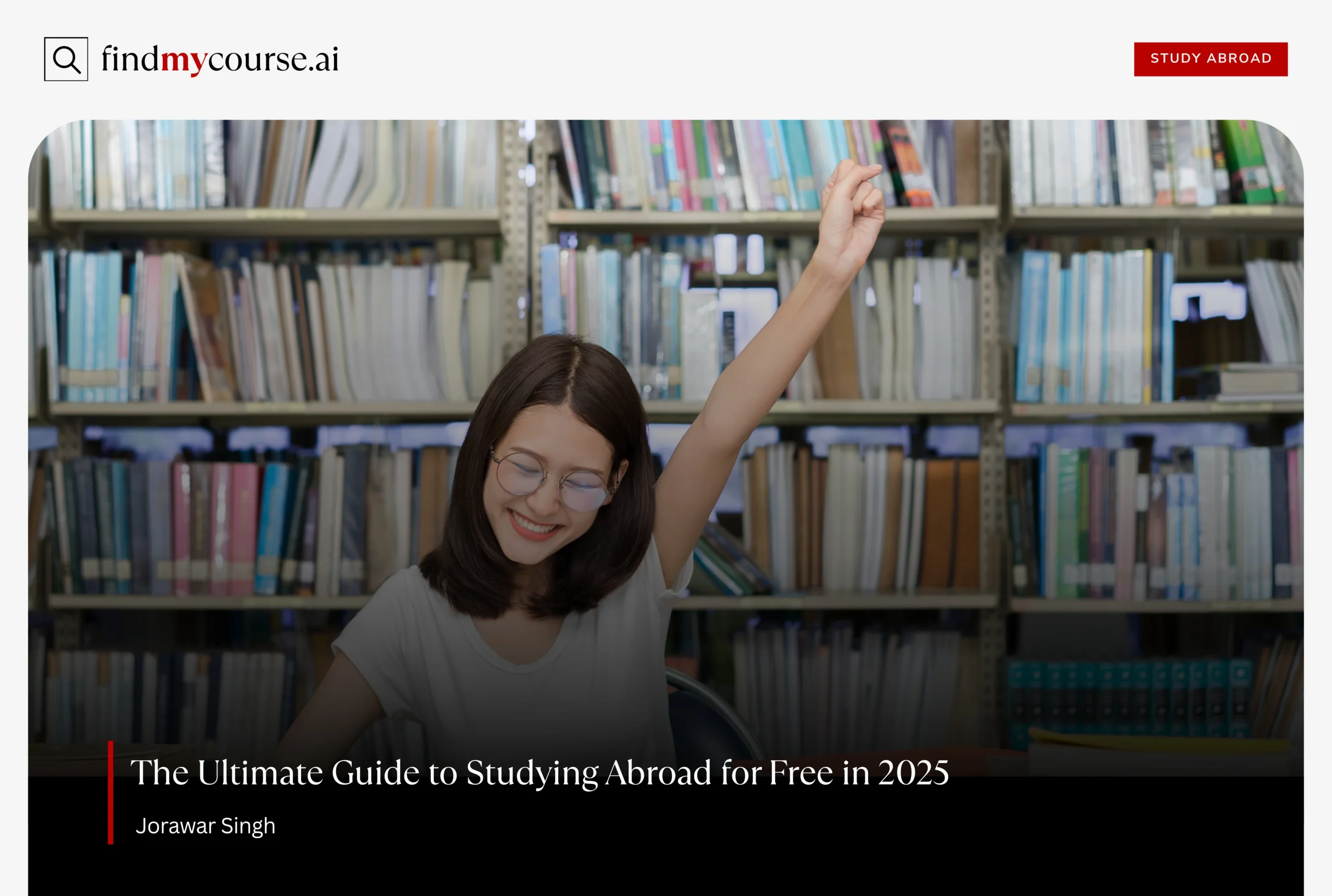Imagine this: You’re scrolling through Instagram, and there it is—your friend sipping espresso in Italy between lectures, another catching cherry blossoms in Tokyo while diving into AI research, and someone else exploring Nordic forests on weekends like it’s just part of their routine. They’re not just on vacation—they’re actually studying abroad. And the best part? They’re doing it without drowning in student debt or maxing out credit cards. Study abroad for free in 2025 isn’t some exclusive club reserved only for the wealthy or those with perfect GPAs and scholarship luck. With the right mindset, a solid game plan, and a bit of hustle, this dream can absolutely become your reality—yes, even if you don’t have connections, loads of savings, or a full-ride scholarship lined up.
To keep everything simple, practical, and doable, I’ll break the process down into clear, bite-sized steps. This guide is all about turning that dreamy vision of study abroad for free into a real, concrete plan you can actually follow.
Why Study Abroad for Free in 2025 is Possible?
Let’s clear something up right away—studying abroad doesn’t have to mean draining your bank account or racking up huge debt just to attend a big-name university in the U.S. or the UK. While those destinations get a lot of attention, they’re definitely not your only options. In fact, there are several countries around the world where you can study abroad for free and get a top-tier education without spending a fortune. And yes, even if you’re coming from halfway across the globe, you can still access affordable or even tuition-free degree programs that don’t compromise on quality.
These alternative destinations are not only budget-friendly but also offer globally recognized degrees, strong academic programs, and vibrant student communities. So, if you’ve been thinking that studying abroad is only for the ultra-wealthy, think again. Here are some of the best Study abroad for free options for 2025 that combine high-quality education with affordability—and might just surprise you.
Best Countries to Study abroad for free in 2025
| Country/Region | Why It Rocks | Tuition Fees | Living Costs (per month) | Pro Tip |
| Germany | Public universities don’t charge tuition—even for international students. | Semester fee €150–€400 (admin + transport) | About €900 | Many English-taught master’s programs, esp. in engineering & business. |
| Norway | Tuition-free for everyone, no strings attached. | Token semester fee €30–€50 | €1,200–€1,500 | Almost everyone speaks English, so easy to adjust. |
| Finland & Sweden | Finland: Free tuition in Finnish/Swedish; English programs have big scholarships. Sweden: Tuition for non-EU, but generous scholarships available. | Varies; scholarships common | Around €1,000 | Learning local language unlocks perks and funding. |
| France | Tuition shockingly low (€170–€600/year). | €170–€600/year | Around €700 (outside Paris) | World-class education plus culture—wine, art, pastries! |
| South Korea & Japan | Scholarships (GKS and MEXT) fully cover tuition, travel, stipend. | Fully funded via scholarships | $800–$1,200 | Blend of cutting-edge tech and rich culture. |
| Hidden Gems: Czech Republic, Poland, Malaysia | Ultra-affordable tuition & living costs. | $2,000–$5,000/year (English programs) | $400–$800 | Look for local scholarships like Czech Government Scholarships or Malaysia’s MTCP. |
💡 Need help choosing? Use a Living Expense Calculator to figure out what’s realistic for your budget.
Top Scholarships to Study Abroad in 2025
Let’s talk about the golden ticket—scholarships. Yes, they’re competitive. And sure, the application process can also feel a bit overwhelming at first. But here’s the truth: with a smart strategy, a proactive mindset, and a personalized touch, you’ve got a real shot at securing one and study abroad for free. The key is to cast a wide net, apply to as many as you qualify for, and tailor each application to clearly show why you deserve that spot.
Top Scholarships for 2025
These major scholarships are fully funded or highly generous, and they’re open to international students—including those from India and other developing nations:
- DAAD (Germany): One of the most popular choices. It covers everything—from tuition fees and travel costs to monthly living expenses. Open for undergraduate, master’s, and PhD programs.
- MEXT (Japan): Highly prestigious and completely funded. It includes tuition, a monthly stipend, and even travel. The bonus? A deep cultural immersion.
- GKS – Global Korea Scholarship: Covers full tuition, living costs, airfare, and even offers Korean language training. A great pick if you want to study in a tech-forward, vibrant country.
- Chevening (UK): This elite UK government scholarship offers full funding for a one-year master’s program at any UK university—plus access to a powerful alumni network.
- Erasmus+ (Europe): Not just one country—this program lets you study across multiple European countries while covering both tuition and living expenses.
- Australia Awards: Designed for students from developing nations. It includes tuition, return airfare, living allowance, and more.
- Stipendium Hungaricum (Hungary): Fully funded scholarship that covers tuition fees, housing support, and a monthly stipend.
- Taiwan MOE Scholarships: Covers full tuition and includes a monthly stipend for students at undergraduate, master’s, and doctoral levels.
Tips to Nail Your Scholarship Application
Now that you’ve got the shortlist, here’s how to stand out from the crowd and actually win these scholarships to study abroad for free:
- Start Early: Ideally, begin your search and prep work 12–18 months before your desired intake. Many top scholarships have early deadlines, so don’t wait.
- Tell Your Story: Your Statement of Purpose isn’t just a formality—it’s your chance to connect. Make it personal, clear, and aligned with the values or goals of the specific scholarship.
- Tailor Every Application: Avoid copy-pasting the same answers. Customize each application to reflect why you’re a strong fit for that specific program.
- Use Trusted Platforms: Explore scholarship listings on sites like ScholarshipPortal, DAAD.de, embassy websites, and official university portals. These are constantly updated and reliable.
- Get Strong Recommendations: Ask professors, mentors, or supervisors who truly know your work and character. Make sure their letters are detailed, personalized, and enthusiastic.
Pro Tip: Try the FindMyCourse AI Assistant. It’s designed to match you with the best scholarships based on your academic background, goals, and nationality—saving you hours of research and boosting your chances of finding the right fit.
How to Apply to Tuition-Free Universities
Yes, tuition-free universities exist. Yes, they’re amazing. And no, you don’t need to empty your bank account to attend.
Top Tuition-Free Schools for 2025
- Germany:
- LMU Munich: Sciences, humanities, interdisciplinary excellence.
- Humboldt University Berlin: Social sciences, law, culture.
- Heidelberg University: Medical and natural sciences leader.
- Norway:
- University of Oslo: Environmental and social sciences, humanities.
- NTNU: Engineering, architecture.
- Finland:
- University of Helsinki: Free if you study in Finnish; scholarships for English tracks.
- Czech Republic:
- Charles University: Free in Czech; funded English programs available.
- Hungary:
- University of Szeged, Eötvös Loránd University: Fully funded through Stipendium Hungaricum.
–>Use FindMyCourse AI Assistant to compare programs, locations, and scholarships in one place.
Working While Studying Abroad: Assistantships and Part-Time Jobs
Balancing work and studies? Totally doable—and financially smart. Many international students take on assistantships or part-time jobs to gain experience, build networks, and support living expenses while studying abroad successfully.
Graduate Assistantships
- What You Get: Tuition waivers + stipend (€500–€1,500/month).
- Where to Look: Department websites, contact professors directly.
- Best For: Grad students in STEM, humanities, and social sciences.
Part-Time Jobs
- Typical Limits: 20 hours/week (varies by country).
- Where You’ll Work: Campus offices, retail, cafes, freelancing gigs.
- Pay: $10–$20/hour depending on the country.
- Perks: Cash, experience, language practice, and resume building.
Use the Living Expense Calculator to see how much you can cover with part-time work.
Need-Based Financial Aid and Bursaries: Don’t Miss Out
These options are often overlooked—but they can seriously help you save money, gain valuable experience, and even make it possible to study abroad for free while managing your expenses.
Where to Find Need-Based Aid
- India: National Overseas Scholarship for SC/ST students = full ride.
- Canada & UK: Many universities offer need-based grants for international students.
- France, Netherlands, EU: Aid available for low-income students.
- University Grants: Check the financial aid page of each school.
📄 Tip: Submit all financial docs early, and be honest and clear in your explanation of need.
Boost Your Resume: Internships While Studying Abroad
Studying abroad is already an amazing experience. But when you pair it with an internship? That’s a total game changer. Moreover, it’s not just about earning credits anymore—it’s about gaining real-world experience, building your international resume, and standing out in a sea of graduates. Thus, you’re not just learning in the classroom—you’re applying those skills in the real world, in a global context.
Where to Look
- Erasmus Internships: Paid gigs all over Europe.
- LinkedIn/Glassdoor: Search for “student internships abroad.”
- Career Centers: University portals often list exclusive roles.
- AIESEC: Offers global internships and volunteer roles.
Hot Industries
- Tech: Google, SAP, Microsoft
- Finance: ING, Barclays, HSBC
- NGOs: UN, Red Cross
- Research: Max Planck Institute, CERN
Government Exchange Programs to Support Your Education
India has partnerships with over 50 countries when it comes to education and student mobility—so why not take full advantage of that? These international agreements often mean easier admission pathways, special scholarships, and even exclusive exchange opportunities just for Indian students.
Where to Start
- education.gov.in: Head to the International Cooperation section.
- ICCR Scholarships: Covers study in India and abroad.
- Embassies: Often list country-specific scholarships and exchanges.
- Study in India Program: A great platform for exchange and funding.
Affordable Hidden Gems for Studying Abroad
These underrated destinations are not only affordable—they often have fewer applicants for scholarships and offer a culturally rich, high-quality education.
Top Picks
| Country | Key Highlights | Tuition Fees | Living Costs (per month) | Notable Universities / Programs |
| Taiwan | MOE scholarships cover tuition and living expenses. English-taught programs available. | Covered by scholarship | $500–$800 | Various public universities with English programs |
| Hungary | Stipendium Hungaricum covers tuition, housing, and stipend. | Covered by scholarship | Covered by scholarship | Eötvös Loránd, University of Szeged |
| Mexico & Turkey | Affordable tuition. Culturally vibrant with growing academic reputation. | $1,000–$3,000/year | ~$400–$700 | Various public and private institutions |
| Malaysia | High-ranking universities with low tuition. | ~$2,000/year | <$600 | Universiti Malaya (top-ranked in Asia) |
| Georgia & Kazakhstan | Emerging destinations for tech, medicine, and business. Low-cost English-taught programs. | Low-cost (varies by program) | <$500 | English-taught programs in medicine, tech, and business fields |
Pro Tip: These places may not be on every student’s radar—but that’s a good thing. Less competition = better chances at funding.
How to Plan Your Study Abroad for free Journey Effectively
You can do all the research in the world, but if you miss a deadline? It’s game over. Here’s how to stay sharp and organized:
Stay on Track
- Create a Spreadsheet: List countries, universities, scholarships, deadlines, and required documents.
- Set Reminders: Check portals and emails weekly for updates.
- Get Ahead: Take your IELTS/TOEFL early, and start asking for recommendation letters 6–12 months before deadlines.
- Join Online Forums: Reddit’s r/studyabroad, or even Facebook groups can be goldmines for tips and insider info.
Write a Standout Statement of Purpose (SOP)
- Be Honest: Why you? What’s your story?
- Be Specific: Tie your goals directly to what the program offers.
- Avoid Fluff: Skip the clichés like “I want to make the world a better place.” Show how you’ll do that.
- End Strong: Share a clear, confident vision of your future after the program.
Embrace the Adventure
At the end of the day, this whole journey is about so much more than just earning a degree. Sure, the academics matter—but it’s also about who you become along the way. Moreover, it’s about pushing yourself outside your comfort zone, learning how to navigate a brand-new culture, and figuring out how to thrive in unfamiliar surroundings.
More importantly, it’s also about discovering strengths you never knew you had—resilience, independence, adaptability, and confidence. Along the way, you’ll grow in ways that textbooks could never teach you. And when it’s all said and done, you’ll return home with much more than just a diploma. You’ll come back with unforgettable experiences, a broader perspective on life, memories that will stay with you forever, and a story that’s 100% yours.
Checklist: Your Action Plan to Study Abroad for Free in 2025
- Research tuition-free countries (Germany, Norway, France, etc.)
- Apply for major scholarships (DAAD, GKS, MEXT, Chevening, etc.)
- Target tuition-free universities
- Look for graduate assistantships or part-time jobs
- Apply for bursaries and need-based financial aid
- Use government exchange programs
- Secure internships to build skills and earn money
- Explore lesser-known, affordable destinations (Taiwan, Hungary, Malaysia)
- Stay on top of deadlines and prepare early
- Join online student communities for advice and support
Ready to Make It Happen?
If you’ve made it this far—huge congrats! You’re already doing more than most people who are still just daydreaming about studying abroad. Taking the time to explore your options, learn the process, and plan your next move means you’re serious—and that alone sets you apart.
Now it’s time to take that next step and turn all this research into action:
👉 Head over toFindMyCourse.ai to get personalized recommendations on study programs, scholarships, and even tuition-free universities that are matched specifically to your goals, background, and interests.
👉 Curious about what this will cost you month-to-month? Use the Living Expense Calculator to create a clear, realistic budget based on your preferred country, city, and lifestyle. This tool helps you see the full picture—so you can plan ahead with confidence and avoid unexpected financial stress.
Your journey to study abroad for free—or close to it—in 2025 officially starts now. The sooner you take action, the more opportunities you’ll have waiting for you. So don’t hold back. Here’s to chasing your dreams, turning them into a reality, and proving to yourself that you’re capable of amazing things.
Keep pushing forward. You’ve got this.
— Jorawar Singh



2 thoughts on “Study Abroad for Free in 2025: Scholarships, Tuition-Free Countries & Tips”
Comments are closed.